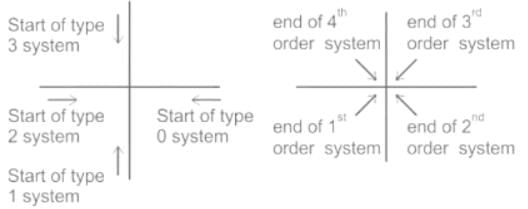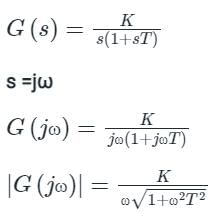Electronics and Communication Engineering (ECE) Exam > Electronics and Communication Engineering (ECE) Questions > If the constant k is negative, then what woul...
Start Learning for Free
If the constant 'k' is negative, then what would be its contribution to the phase plot:
- a)90 degrees
- b)45 degrees
- c)180 degrees
- d)0 degree
Correct answer is option 'C'. Can you explain this answer?
Verified Answer
If the constant k is negative, then what would be its contribution to ...
Polar plot:
- The polar plot of a transfer function G(jω) is the plot of the magnitude of G(jω) versus the phase angle of G(jω) as ω is varied from 0 to positive infinity.
- For all pole systems, type indicates the starting point of the polar plot and order indicates the ending point of the polar plot.

- As seen from the above figure, when a zero is added the type decreases, and the end of the polar plot shifts by +90°.
- When a pole is added, the type of the system increases, and hence the end of the polar plot shifts by -90°.
Calculation:
Let the transfer function be:

Let the transfer function be:

The total phase shift will be:
∠G(jω)H(jω) = -90° - tan-1(ωT) - 180° ----(1)
From equation (1) we can say that constant K has no contribution to the phase plot.
Hence K contributes 180° to the phase plot.
So option (c) is the correct answer.
∠G(jω)H(jω) = -90° - tan-1(ωT) - 180° ----(1)
From equation (1) we can say that constant K has no contribution to the phase plot.
Hence K contributes 180° to the phase plot.
So option (c) is the correct answer.
Most Upvoted Answer
If the constant k is negative, then what would be its contribution to ...
Explanation:
When analyzing the phase plot of a system, we consider the effect of each component separately and then combine them to determine the overall phase shift. In this case, we are considering the effect of a negative constant, denoted as k, on the phase plot.
Effect of a Negative Constant on the Phase Plot:
When the constant k is negative, it means that it has a negative value. This negative value contributes a phase shift to the overall phase plot.
Contribution of a Negative Constant to the Phase Plot:
The contribution of a negative constant to the phase plot can be determined by considering the properties of the complex plane and the concept of complex numbers.
In the complex plane, the negative real axis is oriented at an angle of 180 degrees with respect to the positive real axis. This means that any negative value on the real axis will have a phase shift of 180 degrees.
Since the constant k is negative, its contribution to the phase plot is a phase shift of 180 degrees.
Therefore, the correct answer is option 'C' - 180 degrees.
Summary:
- When the constant k is negative, it contributes a phase shift to the phase plot.
- The contribution of a negative constant to the phase plot is a phase shift of 180 degrees.
- Therefore, the correct answer is option 'C' - 180 degrees.
When analyzing the phase plot of a system, we consider the effect of each component separately and then combine them to determine the overall phase shift. In this case, we are considering the effect of a negative constant, denoted as k, on the phase plot.
Effect of a Negative Constant on the Phase Plot:
When the constant k is negative, it means that it has a negative value. This negative value contributes a phase shift to the overall phase plot.
Contribution of a Negative Constant to the Phase Plot:
The contribution of a negative constant to the phase plot can be determined by considering the properties of the complex plane and the concept of complex numbers.
In the complex plane, the negative real axis is oriented at an angle of 180 degrees with respect to the positive real axis. This means that any negative value on the real axis will have a phase shift of 180 degrees.
Since the constant k is negative, its contribution to the phase plot is a phase shift of 180 degrees.
Therefore, the correct answer is option 'C' - 180 degrees.
Summary:
- When the constant k is negative, it contributes a phase shift to the phase plot.
- The contribution of a negative constant to the phase plot is a phase shift of 180 degrees.
- Therefore, the correct answer is option 'C' - 180 degrees.
Free Test
FREE
| Start Free Test |
Community Answer
If the constant k is negative, then what would be its contribution to ...
Polar plot:
- The polar plot of a transfer function G(jω) is the plot of the magnitude of G(jω) versus the phase angle of G(jω) as ω is varied from 0 to positive infinity.
- For all pole systems, type indicates the starting point of the polar plot and order indicates the ending point of the polar plot.

- As seen from the above figure, when a zero is added the type decreases, and the end of the polar plot shifts by +90°.
- When a pole is added, the type of the system increases, and hence the end of the polar plot shifts by -90°.
Calculation:
Let the transfer function be:

Let the transfer function be:

The total phase shift will be:
∠G(jω)H(jω) = -90° - tan-1(ωT) - 180° ----(1)
From equation (1) we can say that constant K has no contribution to the phase plot.
Hence K contributes 180° to the phase plot.
So option (c) is the correct answer.
∠G(jω)H(jω) = -90° - tan-1(ωT) - 180° ----(1)
From equation (1) we can say that constant K has no contribution to the phase plot.
Hence K contributes 180° to the phase plot.
So option (c) is the correct answer.

|
Explore Courses for Electronics and Communication Engineering (ECE) exam
|

|
Question Description
If the constant k is negative, then what would be its contribution to the phase plot:a)90 degreesb)45 degreesc)180 degreesd)0 degreeCorrect answer is option 'C'. Can you explain this answer? for Electronics and Communication Engineering (ECE) 2025 is part of Electronics and Communication Engineering (ECE) preparation. The Question and answers have been prepared according to the Electronics and Communication Engineering (ECE) exam syllabus. Information about If the constant k is negative, then what would be its contribution to the phase plot:a)90 degreesb)45 degreesc)180 degreesd)0 degreeCorrect answer is option 'C'. Can you explain this answer? covers all topics & solutions for Electronics and Communication Engineering (ECE) 2025 Exam. Find important definitions, questions, meanings, examples, exercises and tests below for If the constant k is negative, then what would be its contribution to the phase plot:a)90 degreesb)45 degreesc)180 degreesd)0 degreeCorrect answer is option 'C'. Can you explain this answer?.
If the constant k is negative, then what would be its contribution to the phase plot:a)90 degreesb)45 degreesc)180 degreesd)0 degreeCorrect answer is option 'C'. Can you explain this answer? for Electronics and Communication Engineering (ECE) 2025 is part of Electronics and Communication Engineering (ECE) preparation. The Question and answers have been prepared according to the Electronics and Communication Engineering (ECE) exam syllabus. Information about If the constant k is negative, then what would be its contribution to the phase plot:a)90 degreesb)45 degreesc)180 degreesd)0 degreeCorrect answer is option 'C'. Can you explain this answer? covers all topics & solutions for Electronics and Communication Engineering (ECE) 2025 Exam. Find important definitions, questions, meanings, examples, exercises and tests below for If the constant k is negative, then what would be its contribution to the phase plot:a)90 degreesb)45 degreesc)180 degreesd)0 degreeCorrect answer is option 'C'. Can you explain this answer?.
Solutions for If the constant k is negative, then what would be its contribution to the phase plot:a)90 degreesb)45 degreesc)180 degreesd)0 degreeCorrect answer is option 'C'. Can you explain this answer? in English & in Hindi are available as part of our courses for Electronics and Communication Engineering (ECE).
Download more important topics, notes, lectures and mock test series for Electronics and Communication Engineering (ECE) Exam by signing up for free.
Here you can find the meaning of If the constant k is negative, then what would be its contribution to the phase plot:a)90 degreesb)45 degreesc)180 degreesd)0 degreeCorrect answer is option 'C'. Can you explain this answer? defined & explained in the simplest way possible. Besides giving the explanation of
If the constant k is negative, then what would be its contribution to the phase plot:a)90 degreesb)45 degreesc)180 degreesd)0 degreeCorrect answer is option 'C'. Can you explain this answer?, a detailed solution for If the constant k is negative, then what would be its contribution to the phase plot:a)90 degreesb)45 degreesc)180 degreesd)0 degreeCorrect answer is option 'C'. Can you explain this answer? has been provided alongside types of If the constant k is negative, then what would be its contribution to the phase plot:a)90 degreesb)45 degreesc)180 degreesd)0 degreeCorrect answer is option 'C'. Can you explain this answer? theory, EduRev gives you an
ample number of questions to practice If the constant k is negative, then what would be its contribution to the phase plot:a)90 degreesb)45 degreesc)180 degreesd)0 degreeCorrect answer is option 'C'. Can you explain this answer? tests, examples and also practice Electronics and Communication Engineering (ECE) tests.

|
Explore Courses for Electronics and Communication Engineering (ECE) exam
|

|
Signup for Free!
Signup to see your scores go up within 7 days! Learn & Practice with 1000+ FREE Notes, Videos & Tests.























